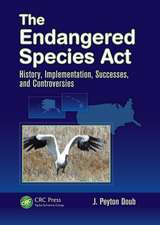Organic Xenobiotics and Plants: From Mode of Action to Ecophysiology: Plant Ecophysiology, cartea 8
Editat de Peter Schröder, Christopher D. Collinsen Limba Engleză Paperback – 2 ian 2013
| Toate formatele și edițiile | Preț | Express |
|---|---|---|
| Paperback (1) | 945.62 lei 43-57 zile | |
| SPRINGER NETHERLANDS – 2 ian 2013 | 945.62 lei 43-57 zile | |
| Hardback (1) | 950.52 lei 43-57 zile | |
| SPRINGER NETHERLANDS – 8 noi 2010 | 950.52 lei 43-57 zile |
Preț: 945.62 lei
Preț vechi: 1153.19 lei
-18% Nou
Puncte Express: 1418
Preț estimativ în valută:
180.95€ • 189.40$ • 150.60£
180.95€ • 189.40$ • 150.60£
Carte tipărită la comandă
Livrare economică 31 martie-14 aprilie
Preluare comenzi: 021 569.72.76
Specificații
ISBN-13: 9789400734067
ISBN-10: 9400734069
Pagini: 320
Ilustrații: VIII, 311 p.
Dimensiuni: 155 x 235 x 17 mm
Greutate: 0.45 kg
Ediția:2011
Editura: SPRINGER NETHERLANDS
Colecția Springer
Seria Plant Ecophysiology
Locul publicării:Dordrecht, Netherlands
ISBN-10: 9400734069
Pagini: 320
Ilustrații: VIII, 311 p.
Dimensiuni: 155 x 235 x 17 mm
Greutate: 0.45 kg
Ediția:2011
Editura: SPRINGER NETHERLANDS
Colecția Springer
Seria Plant Ecophysiology
Locul publicării:Dordrecht, Netherlands
Public țintă
ResearchCuprins
Preface.- Part I. PRINCIPLES OF TRANSPORT, DEPOSITION AND UPTAKE. 1. Plant Uptake of Xenobiotics; C. Collins et al.- 2. Haloorganics in temperate forest ecosystems: sources, transport and degradation; N. Clarke et al.- 3. Semivolatiles in the forest environment; C.A. Belis et al.- Part II. CASE STUDIES. 4. A case study: Uptake and Accumulation of Persistent Organic Pollutants in Cucurbitaceae species; A. Bittsánszky et al.- 5. Trichloroacetic acid in the forest ecosystem. Introduction; M. Matucha, P. Schröder.- 6. Persistent organic pollutants (POPs) in Switzerland related to long-range transboundary transport; R. Herzig et al.- Part III. POLLUTANT DEGRADATION AND ECOSYSTEM REMEDIATION FROM ENZYMES TO WHOLE PLANTS. 7. New perspectives on the metabolism and detoxification of synthetic compounds in plants; R. Edwards et al.- 8. Using plants to remove foreign compounds from contaminated water and soil. Introduction; J.-P. Schwitzguébel et al.- 9. Biodegradation of Organic Xenobiotic Pollutants in the Rhizosphere; H. Azaizeh et al.- 10. Bioindicators and Biomonitors: Use of organisms to observe the influence of chemicals on the environment; B. Markert et al.- 11. SAR Based Computational Models as Decision Making Tools in Bioremediation; N. Price, Q. Chaudhry.- 12. State-of-the-art Chemical Analyses: Xenobiotics, Plant Proteomics, and Residues in Plant Based Products; T. Solouki et al.- Index.-
Textul de pe ultima copertă
Natural and agro-ecosystems are frequently exposed to natural or synthetic substances, which, while they have no direct nutritional value or significance in metabolism, may negatively affect plant functioning. These, xenobiotics, may originate from both natural (fires, volcano eruptions, soil or rock erosion, biodegradation) and anthropogenic (air and soil pollution, herbicides) sources. And, while affected plants have only a limited number of possibilities for avoiding accumulation of these compounds, they do exhibit several enzymatic reactions for detoxification including oxidation, reduction, hydrolysis and conjugation reactions. In agro-ecosystems in particular these mechanisms have great significance in relation to herbicide detoxification and tolerance. In this volume an international group of experts present an overview of the nature and distribution of organic xenobiotics, including their uptake, effects on plant functioning and detoxification mechanisms. The particular significance of glutathione S-transferases in bio-indication and bio-monitoring, and in the detoxification of volatile organic air pollutants and herbicides is evaluated, and their potential significance in phytoremediation and bioaccumulation will be discussed. This volume will be of interest to a wide audience, from graduate students to senior researchers in a wide range of disciplines including plant ecology, plant biochemistry, agriculture and environmental management. It will also be of practical interest to environmentalists, policy makers and resource managers.
Caracteristici
Only up-to-date treatment of xenobiotics in plants Includes practical applications to real-life problems Relates to food safety and bioremediation


















